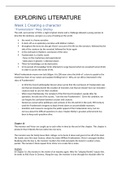EXPLORING LITERATURE
Week 1 Creating a character
‘’Frankenstein’’ Mary Shelley
The cold, wet summer of 1816, a night of ghost stories and a challenge allowed a young woman to
describe the darkness, and give us a way of looking at the world.
the novel is a frame narrative
It starts off as an epistolary narrative with Walton's letters
throughout the story we also get Victor's account of his life (as the narrator), followed by the
tale of the creature (as the narrator) followed by Victor again
in the end back to Walton's conclusion of the story
Frankenstein is a Gothic novel:
- focus on the mysterious and supernatural
- takes place in gloomy / unknown places
Thirst for knowledge can be destructive
In his pursuit of knowledge Victor attempts to surge beyond what are accepted human limits
in order to access the secret of life.
What Frankenstein means now Jack Stilgoe: It is 200 years since the birth of ‘a story to speak to the
mysterious fears of our nature and awaken thrilling horror’. Why are we still so interested in the
story of Frankenstein?
- In 2012 the French philosopher Bruno Latour wrote that the real lesson of Frankenstein was
not that we should prevent the creation of monsters, but that we should ‘love our monsters’:
creators need to care for their creations
- When Louis Washkansky, the recipient of the first heart transplant, awoke after his
operation, he told one of his nurses, “I am the new Frankenstein”. Given his condition, we
can forgive the confusion between creator and creature
- Numerous conservative politicians and cartoons in the US and UK in the early 19th Century
used the Frankenstein imagery to depict freed slaves as uncontrollable monsters.
- Scientists and museums recognise the public appeal of the Frankenstein story, but are
nervous about the difficult questions it raises. Maybe Shelley’s greatest achievement has
been to keep such questions alive.
Chapter 16
The monster and Victor are caught up to each other in time by the end of this chapter. This chapter is
pivotal in that it blends the two sides into one story.
The monster sees his family leave their cottage, so he burns it down and goes to live off of the land.
His travels carry him near Geneva, where he meets William Frankenstein, Victor's youngest brother.
Realizing who the boy is, the monster murders the child and plants the locket in Justine's dress
pocket. The monster's final request from Victor is to create him a mate.
Analysis
In Chapter 16, the monster is the victim of an injustice again. After his "adopted family" rejects him,
he seeks to find Victor in Geneva. Along the way, the monster is shot through the shoulder after he
, saves a little girl from drowning in a stream. Recognized and shot as a villain, he is not seen as the
savior he really is. He curses all men and, "inflamed by pain," he vows "eternal hatred and vengeance
to all mankind." He passes a fall, winter, and spring in the woods, traveling at night to reach Geneva.
In a search for food and shelter, the monster encounters young William Frankenstein and kills him.
He claims, "I too can create desolation, my enemy is not invulnerable; this death will carry despair to
him, and a thousand other miseries shall torment and destroy him." The monster takes the locket
from William, goes into a barn for rest, and finds Justine sleeping in the hay. He puts the locket of
William's mother into Justine's pocket.
Chapter 17
The monster and Victor finish their conversation in a hut on the slopes of Montanvert. This important
chapter is where the monster confronts his maker with an all or nothing proposition: "make me a
mate or I will destroy you." He convinces Victor to once again re-create the process first used on the
monster. Victor sees the monster's point of view and agrees to create a mate for the monster.
Analysis
The monster tells Victor: "You must create a female for me with whom I can live in the interchange of
those sympathies necessary for my being." Victor refuses and then later relents to the monster's
wishes. The monster threatens "I will work at your destruction, nor finish until I desolate your heart,
so that you shall curse the hour of your birth." The monster also pleads his case saying, "My creator,
make me happy and do not deny my request." The creature further promises to move far away from
continental Europe to the wilds of South America.
It is interesting to note that Mary Shelley doesn't mention the monster's sexual needs although he
wants a mate for companionship. The first letter written by Walton to his sister mentions this desire
for companionship as well.
Victor has second thoughts only to be moved by the monster's arguments. At this point, Victor and
his creation should be thought of as equals. What the monster lacks is a formal education and the
knowledge to create his own mate.
When Victor returns to Geneva to make preparations, his family is alarmed at his "haggard and wild
appearance." Again, Victor is plunged into the abyss of despair and depression.
‘’Wodwo’’ Ted Hughes
What is a wodwo?
Refers to some sort of goblin creature, a sort of half-man, half-animal, spirit of the forest.
What question does the wodwo ask?
‘’What am I?’’ ‘’How do I fit in?’’
Does he answer it?
No, he’s still looking for the answer.
Literary devices:
Free verse
Alliteration: ‘’The glassy grain’’
Stream of consciousness: he keeps asking questions.
Enjambment.
First-person
The link to Frankenstein:
The question the creature asks.





